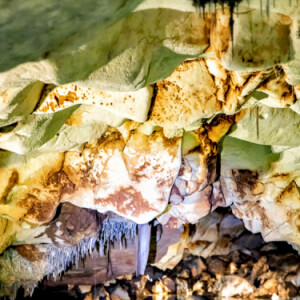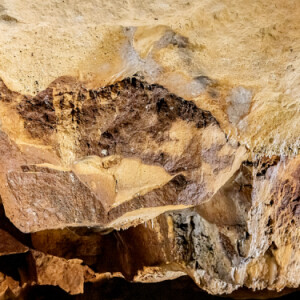La Cova de s'Aigua.
Today Lisa and I set off at sparrow's fart, for a pre-booked guided tour of the recently excavated water cave at Cala Blanca near Ciudadella. Initially we were the only ones there, but were joined by a holidaying Swiss couple who were passing by. Expecting an underground cave with a lake to be chilly, I was wearing thick walking trousers, vest and jumper, but it was surprisingly warm. Apparently the temperature in there stays constant at 22 degrees C throughout the seasons. Some information here:
"The Cova de s’Aigua is located in the center of Cala Blanca, a southern suburb of Ciutadella de Menorca. It is a natural cave which has an underground connection to the nearby sea, the cave lake contain brakish water and the level changes with the tides. It formed inside calcarenites and limestone from the Upper Miocene (Tartonian and Messinian). At Cala Blanca there are numerous similar caves, this is the only one which is open to the public. It was closed for many decades, but has been opened 2021 with new trails, LED light system and a special elevator for wheelchairs. There will be a second phase, the 2016 discovered nearby cave will be added to the route.
In the entrance are of the cave numerous remains like ceramic fragments and some small vases were discovered. They are thought to belong to the pre-Talayotic and Talayotic culture. They are very similar to those found in a nearby domestic-type structure, the naveta of Cala Blanca. This site was excavated in the 1980s and the pre-Talayotic findings were dated 1700 BC and the Talayotic findings about 1200 BC. However, there was no archaeological excavation in the cave, the item were collected during the examination of the cave for its suitability as a show cave. In the lake human skeletal remains can be seen, which belong to a burial area located on the other side of the lake.
The cave was known since prehistoric times, the oldest remains beneath the archaeological remains are graffities, the oldest from 1580. More inscriptions are from the 18th century, when Menorca was under British domination. There are numerous British names, like the "Lord Forbes governour 1717", or the "Lieutenant J. Wickhman of the British Grenadier Corps". The second has added two dates, he visited the cave twice, on May 10 and on June 17, 1717. "
Needless to say, the spectacle is fantastic, the colours of the forming stalactites and stalagmites looking like candle wax, then cinder toffee before fully hardening into granite. The guide was incredibly knowledgable and gave masses of techical information about the composition of the rocks, the minerals and the enormous timescale which led to what is there today. I was struck by the note from Lieutenant J. Wickhman of the British Grenadier Corps written in 1717 in charcoal, still visible today despite all the moisture. Too many pictures taken - a handful in extras - which are terribly noisy as no flash or tripod was allowed, and I had to hand hold the camera so no long exposures. I'd love to be allowed in with full equipment but this is a taste of what it is like. The cave closes this weekend until Spring. Certainly well worth a visit.
I've tagged it for abstract Thursday as it is one of Nature's abstracts, not created by me except to click the shutter and try to reduce the grain a little.




Comments
Sign in or get an account to comment.


